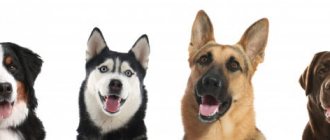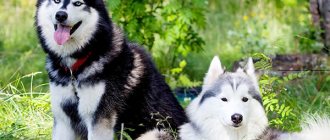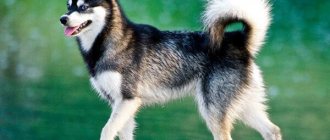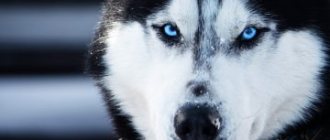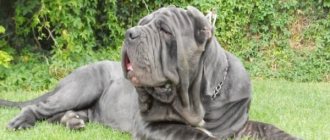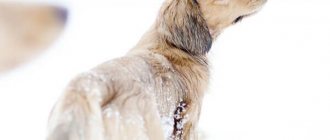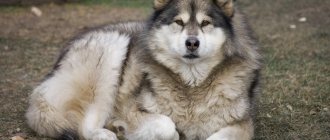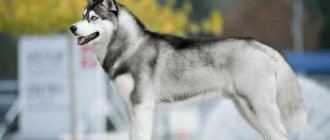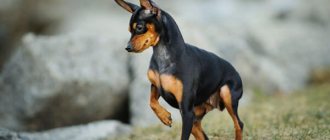Blue-eyed huskies look very unusual, since this eye color is unusual for representatives of most breeds.
In dogs, it is usually found with a marbled color, which in Siberian Huskies is considered extremely rare and atypical for representatives of this breed.
How did it happen that almost all huskies have sky blue or light blue eyes? And why are they more often found in combination with black, gray, brown colors and only rarely in dogs that have a white color?
And what exactly, according to the breed standard, should a husky's eye color be?
Blue-eyed dogs - breed standard
Most often, huskies have eyes of a cool sky blue shade with a dark black outline. Owners of this look are usually dogs with black and white, gray and white or gray coat colors. Pure white huskies with bright eyes are a rare occurrence; becoming the owner of such a dog is considered real luck.
Many people strive to buy a dog with a blue tint to the iris, because this phenomenon is rare in the animal world. Husky is practically the only breed whose standards allow the appearance of such individuals.
Scientists explain the unusual “icy” look of the husky by the special structure of the genes: in blue-eyed individuals, a doubling of a genome section on the 18th chromosome was discovered.
Common Siberian Husky Colors
There is no clear classification of husky colors. Dogs differ in the location of spots, markings, facial mask, eye and nose color.
World dog experts distinguish not four (as in the Russian Federation) color variations, but about twenty. The most common among them:
- brown;
- gray;
- chocolate;
- fawn;
- silver
Brown
Another name for brown color according to the standard is red. Hasyats are often born with red tops and white bottoms. In summer, under the bright sun, the coat fades a little, turns pale and the tone becomes less saturated. During this period, huskies are more beige than brown, and they are called yellow, which is a mistake. The eyes, which have several color variations, give the animals a special charm and uniqueness. Brown dogs with blue eyes and dark “glasses” around them look especially impressive. Over time, they can disappear, turning into a slightly noticeable outline.
Very often, newly born Khasenys have a rich fiery color. After the first molt, the puppies change color and turn into a white dog with light brown spots.
Gray (wolf)
The gray color is called wolf because of its similarity to the color of predators. In addition to the main color, it contains small inclusions of red and fawn. The spots are most noticeable behind the ears, on the neck, thighs, legs and hocks. The undercoat of gray hasenies is beige, the rims of the eyes, lips and nose are black.
Very often, gray-white cats with blue eyes are born. The shade of the coat can be either light or dark, the undercoat can be gray, cream or beige. If the coat is silver, the undercoat is white, as is the belly and paws. The mask on the face and the upper back are gray. Hasyats with wolf coloring have brown, multi-colored or blue eyes.
Chocolate
The richness of the chocolate color of the coat varies - from light cream to dark brown. Copper-colored dogs, which are lighter and brighter than chocolate, look most impressive. In combination with blue eyes, the suit looks amazing. Eye rims, nose, lips should be brown. More often, white-chocolate hasyats are born - with a light bottom, a darker back, brown, blue or different eyes.
Pale yellow
The fawn color is close in tone to red, but not as rich, more subdued. A noble pastel shade reminiscent of cream or beige. The pigmentation of the rims of the eyes, lips and nose is brown.
If the chicks are born fawn-white, the top of the body is initially brighter. Over time, the shade fades and differs very little from the main color.
Silver
The most striking of the light husky colors is silver. In the sun, the coat shimmers due to the combination of the white background of the undercoat and the shiny gray guard.
In silver-white huskies, the mask is clearly expressed, as is the “arrow” on the forehead. Such Khasenys are characterized by dark eye rims and a bright blue iris. Another name for the silver color is “silver”.
Different iris color
The breed standard is not limited to just the blue tint of the iris. You can often find Huskies with deep brown or black looks. As a rule, such individuals have a more saturated coat color, for example, black with splashes of white. Huskies with warm brown coats often have reddish-amber eyes. Sometimes there are representatives of the breed with olive-colored eyes.
Despite the fact that many strive to become the owner of a dog with blue eyes, brown-eyed individuals are considered more practical. The sky-hued iris is more sensitive to light. In conditions of frequent and heavy snowfalls, you can notice that blue-eyed huskies are constantly squinting their eyes. In addition, it is believed that individuals with a dark look are more resistant to disease.
What is the reason for the variety of colors?
Husky was bred by the peoples of the Far North based on local dogs and wolves. Selection for many centuries was carried out on the principle of selecting the most hardy and efficient individuals that can easily withstand harsh climatic conditions. They not only have to run in a harness, but also sleep in the snow. That is why minimal attention was paid to appearance, and the closest attention was paid to working qualities and health. This is how huskies of different colors appeared.
According to the standard approved by the IFF, the color can be anything from white to black. Different colors in all possible combinations, marks on the body or their complete absence are acceptable.
In the Russian Federation, the approach to this issue is more conservative - white color or its combination with black, gray or brown is considered the standard. But the rest of the colors are not considered a marriage, especially since Khasenys have such individual colors that it is extremely difficult to find two absolutely identical puppies.
Odd-eyed dogs
Another rare phenomenon found in this breed is heterochromia, in which the organs of vision have different colors: one is blue and the other is brown. There are two varieties of this phenomenon:
- complete heterochromia implies a pure shade: one eye is completely dark, the other is completely blue;
- with sectoral heterochromia, two colors can be mixed even in one iris: a blue eye will include brown inclusions.
Due to the desire of dog breeders to show off an unusual individual, Husky puppies with heterochromia of the visual organs are often sold at a higher price, although otherwise they are no different from other representatives of the breed.
What is the name of?
Heterochromic Huskies are nicknamed "Harlequins". Such odd-eyed dogs are of particular interest at exhibitions and become a source of pride for the owner. It is believed that the appearance of an unusual dog in the house necessarily promises happiness and good luck.
Normal or defective breed?
Congenital heterochromia is considered completely normal for Huskies. Dog handlers do not associate different eye colors with the presence of diseases or other characteristics of the body. In this case, the pet’s extravagant look should not cause concern.
Phenomena such as clouding of the iris or the appearance of swelling in the area of the pet’s eyes should alert you.
Why different?
Hereditary heterochromia is most often associated with a deficiency or, conversely, an excess of melanin , a natural substance responsible for the intensity of color. Another reason for this phenomenon may be the crossing of two individuals with different eye colors.
But acquired heterochromia also occurs, when a change in the color of the iris becomes a consequence of an illness or prolonged treatment with potent drugs. An arbitrary change in color may indicate the presence of a pathology of the organ of vision or other serious problems with the dog’s health.
If you notice that the color of your Husky's eyes has changed, take your pet to the vet immediately to determine the cause of this phenomenon.
Abstract description of the Husky breed
Molting occurs twice a year. Mostly moderate, but during the shedding season a large amount of hair falls out, so you will have to brush your dog daily.
Huskies do quite well in apartments, provided they have the opportunity to exercise. The ideal place to keep it is a private country house.
If the animal does not find an outlet for its violent energy, it will begin to chew the slippers. In the courtyard of a country house, huskies will dig holes under the fence and loosen the ground.
Husky dogs practically do not bark, even when someone unfamiliar approaches their home territory. Therefore, this breed is not used as a guard dog.Due to their stubborn nature, these dogs are not suitable for novice dog owners. They certainly need a leader in the person of a strict master.
Since huskies are curious, they often get injured and get lost when leaving their home.
These good-natured animals are ideal pets for families with children.
When buying a husky puppy, you should find out about its diet. They generally don't need a lot of high calorie food.During walks, it is recommended to let the animal off a leash to give it the opportunity to chase small representatives of the fauna.
Photo
Further in the photo you can see white and other colored adult dogs and husky puppies with blue, brown and different eyes.
Controversial and rare suits
White
Pure white huskies are rare. It looks especially effective if the dog has blue eyes.
When the white color is the result of a strong lightening of the piebald, the dog will have barely noticeable colored hairs around the eyes, on the rump and ears.
Black
Siberian Huskies do not have completely black colors (another name for Afro). For a suit to be recognized as such, it must be at least 75% dark in color. Light blotches are allowed on the limbs, chest, and tip of the tail; a white stripe is possible on the muzzle.
Black and tan
A relatively rare suit, it is also called tricolor or tricolor. The undercoat is brown, the guard hair is predominantly black, and tan – reddish-peach markings – are found on the chest, muzzle and paws.
Sable
Similar to a wolf, but with a bright red or copper undercoat. The color of the guard hair is unusual: it is black at the tip and fawn in the middle. The inclusions are the same as with the zonal suit, but more saturated, even dark brown.
Agouti
A very rare color, you can find it in working dogs living in the North. The guard coat is any shade of gray or black, a combination of both can form stripes on the body. The undercoat is light brown.
The key differences between the agouti color are the black tassel of the tail and the dark mask that fills almost the entire muzzle. Occasionally you come across dogs with white and red markings interspersed in their masks.
Cheprachny
Another designation is saddled. The name speaks for itself - these huskies have a patch of brown, red, gray or black wool on their back, reminiscent of a saddle. In other places the coat is white or light shades.
Piebald
It is also called piebold. On a white background (at least 70%) there are colored markings from red to black. The spots are round and asymmetrical.
Splash coat
Similar to the piebald color, only there is a light “collar” around the neck. The spots are bright, of any color, monochromatic. The eyes are often bright blue.
Isabella
The Isabella color is close to white, but on the back (from the withers to the croup) the tips of the hairs are colored in light red, golden or fawn tones.
Breeders have different opinions regarding the Isabella color. Some consider it a separate color, others say that it is a white tone obtained as a result of lightening the piebald.
Marble
Another unusual suit, around which there is controversy. Marble or harlequin color cannot be confused with another: dark spots of different sizes are randomly scattered on a white background.
When is coloring determined in puppies?
Almost all huskies are born with bright blue irises. Newborn puppies begin to open their eyes around the 20th day after birth, and the retina completes its formation on the 21st - 22nd day.
At about six months of age, the color of a husky's eyes begins to change and does not always remain blue. Therefore, when purchasing a puppy under the age of six months, you cannot be absolutely sure of the pet’s future color.
Husky eyes are the hallmark of this breed. By deciding to become the owner of a husky, you will get yourself a friend with soulful blue or deep brown eyes. Or maybe a real “harlequin” will settle in your house.
Breed Traits
The main value of dogs of this breed is intelligence and unprecedented endurance. It is important for them to engage in various types of work throughout their lives in order to feel like the happiest creatures.
Without mental stimulation, the Husky dog becomes bored and destructive.
These are naturally predatory animals, so they deftly and skillfully track down and pursue small fellows.For huskies, it is important to maintain a clear hierarchy, showing who is the leader in the pack, because this dog always tries to assert superiority. These are very family animals with a cheerful, playful disposition.
If a small husky is taught to live with other animals in the house, then in the future there will be no problems with family pets living together.
- Newfoundland - history of the breed, education, care + 73 photos
Chihuahua - history of the breed, description, temperament, attitude towards people and animals, care + 92 photos
- Brussels Griffon - history, modern appearance, standards, character and content + 77 photos
Thanks to its mobility, the representative of the breed will be an excellent companion for active, cheerful people.
The husky's peculiarity is expressed in the ability to open doors, jump over and undermine fences and in search of adventure, as a result of which they can get lost and wander.
Judging by the numerous photos of huskies with people, the fashion for this breed is growing every day.
However, before purchasing a pet in the form of a husky, you should carefully study the characteristics of the character and maintenance of these animals.
Agouti
The color is rare.
It differs from others by mixing three shades of fur - black, red and white.
Agouti color husky
The base of the hairs of this coat color is light, then there is an alternation of black, red and black again.
Agouti color husky
The pigmentation of the muzzle looks like a mask of mixed multi-colored hairs, the tip of the tail is black.
Splash coat
Often the splash coat color is confused with the classic pebold color or they are considered to be one and the same.
Husky in a “coat” and “hat” - splash coat color
The opinion is erroneous, since the main difference in the shade of splash wool is the presence of a unique light ring located around the animal’s neck, like a collar.
Red Husky Splash Coat
The main color is white, the “coat” is dark or bright.
Black and white
A very impressive combination of coat and undercoat colors.
Blue-eyed husky puppy
The distribution of shades on the body is approximately the same .
Photo courtesy: Irina Maksimova (Sergeeva) is a professional breeder with RKF registration “From the Snow Legion”.
From the top from the head to the tail there is a solid black color, from the bottom from the muzzle to the paws it is white.
Husky care
There is a stereotype that huskies are very difficult to care for. But in fact, the main difficulty is only that the dog needs constant physical and mental stress. In other matters, residents of the far north are quite unpretentious.
Conditions of detention
Although huskies are now often kept in apartments, they are not made for four walls. A dog feels best outside the city when it has its own home and a large area. Otherwise, be prepared to walk the dog for hours and look for places where it can run around to its fullest.
Photo: pet-master.ru
Hygiene
Oddly enough, caring for huskies is quite simple - they don’t even need to be bathed. Moreover, an unpleasant odor often appears precisely because of water procedures that disrupt the natural balance. But be sure to comb the fur, brush the teeth and periodically examine the eyes and ears.
Photo: mocah.org
Walks
Huskies need intense exercise, otherwise they simply become destructive to everything around them. They need to run a lot and engage in active leisure activities. They willingly participate in sports, go hiking and overcome obstacle courses. It is strictly forbidden to leave an untrained husky in a new unfenced area alone and without a leash.
Photo: siberians.ru
Education and training
Huskies are not at all aggressive, so training does not cause problems in this regard. But they are smart, willful and independent - sometimes this causes difficulties when the dog must follow a standard algorithm. For the same reason, huskies are not used instead of service dogs, and it is recommended to train them in a playful way.
Photo: siberians.ru
Scottish Fold cats: description, character and care
Marble
This color is characterized by uneven coloring of the coat and mixing of light and dark areas.
Marbled husky puppy
The base color is usually white, with randomly colored dark gray, light gray or black on the face, back, hips, and tail. Black eye rim.
Marble HuskyPinto Husky
This animal's fur looks very fancy and immediately attracts the eye .
Content Features
Dogs of the Siberian Husky breed, of course, stand out among the huge variety of breeds of “human friends”. However, a person who decides to purchase this dog with an unforgettable expressive look should carefully familiarize himself with all the features of raising and keeping this breed.
Such dogs require long active walks; they do not tolerate long stays in a stuffy room, as well as a lack of intense physical activity. Moreover, the option of keeping a dog year-round in an outdoor enclosure seems to be virtually ideal. A dog of this breed is suitable for a person with an active lifestyle, a strong, stable character, who has sincere love and respect for his four-legged friend. See the article: Spaniel dog: tips on feeding and maintaining the breed.
Health and disease of the breed
The Siberian Husky is one of the healthiest breeds, because northern latitudes dictate their own requirements. Most often, owners are faced with thyroid disorders, diabetes and eye diseases. Huskies occasionally suffer from epilepsy, but modern treatment allows the situation to be kept under control.
Be sure to watch how the dog walks and runs. Huskies are very active, and any abnormalities may indicate incipient muscle or joint problems. You also need to control your weight and do not forget about scheduled deworming.
Photo: pinterest.ru
Pomeranian Spitz: breed description and care (60 photos)
